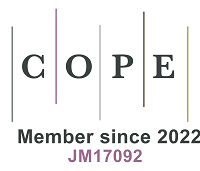REFERENCES
1. World Health Organization. Compendium of WHO and other UN guidance on health and environment, 2022 update. Available from: https://apps.who.int/iris/handle/10665/352844 [Last accessed on 23 Feb 2023].
2. Alford KL, Kumar N. Pulmonary health effects of indoor volatile organic compounds-a meta-analysis. Int J Environ Res Public Health 2021;18:1578.
3. Maung TZ, Bishop JE, Holt E, Turner AM, Pfrang C. Indoor air pollution and the health of vulnerable groups: a systematic review focused on particulate matter (pm), volatile organic compounds (VOCs) and their effects on children and people with pre-existing lung disease. Int J Environ Res Public Health 2022;19:8752.
4. Montero-Montoya R, López-Vargas R, Arellano-Aguilar O. Volatile organic compounds in air: sources, distribution, exposure and associated illnesses in children. Ann Glob Health 2018;84:225-38.
5. International Agency for Research on Cancer. Benzene Volume 120. Available from: https://publications.iarc.fr/576 [Last accessed on 23 Feb 2023].
6. U.S. Environmental Protection Agency. Toxicological Review of Toluene. Available from: https://www.epa.gov/sites/default/files/2014-03/documents/toluene_toxicology_review_0118tr_3v.pdf [Last accessed on 23 Feb 2023].
7. United States Environmental Protection Agency. Chemical assessment summary- ethylbenzene; CASRN 100-41-4. Available from: https://cfpub.epa.gov/ncea/iris/iris_documents/documents/subst/0051_summary.pdf [Last accessed on 23 Feb 2023].
8. United States Environmental Protection Agency. Chemical assessment summary-xylenes; CASRN 1330-20-7. Available from: https://iris.epa.gov/static/pdfs/0270_summary.pdf [Last accessed on 23 Feb 2023].
9. World Health Organization. Air quality guidelines for Europe (Second edition). Available from: https://apps.who.int/iris/handle/10665/107335 [Last accessed on 23 Feb 2023].
10. Loren Raun. Benzene Risk: Determining carcinogenic health risk concentration levels for benzene in ambient air at EPA, TCEQ and the City of Houston. Available from: http://www.greenhoustontx.gov/reports/benzenerisk.pdf [Last accessed on 23 Feb 2023].
11. Moolla R, Curtis CJ, Knight J. Occupational exposure of diesel station workers to BTEX compounds at a bus depot. Int J Environ Res Public Health 2015;12:4101-15.
12. Rostami R, Fazlzadeh M, Babaei-Pouya A, et al. Exposure to BTEX concentration and the related health risk assessment in printing and copying centers. Environ Sci Pollut Res Int 2021;28:31195-206.
13. Heibati B, Pollitt KJG, Karimi A, et al. BTEX exposure assessment and quantitative risk assessment among petroleum product distributors. Ecotoxicol Environ Saf 2017;144:445-9.
14. Dehghani M, Fazlzadeh M, Sorooshian A, et al. Characteristics and health effects of BTEX in a hot spot for urban pollution. Ecotoxicol Environ Saf 2018;155:133-43.
15. Kermani M, Asadgol Z, Gholami M, et al. Occurrence, spatial distribution, seasonal variations, potential sources, and inhalation-based health risk assessment of organic/inorganic pollutants in ambient air of Tehran. Environ Geochem Health 2021;43:1983-2006.
16. Latif MT, Abd Hamid HH, Ahamad F, et al. BTEX compositions and its potential health impacts in Malaysia. Chemosphere 2019;237:124451.
17. Dörter M, Mağat-Türk E, Döğeroğlu T, et al. An assessment of spatial distribution and atmospheric concentrations of ozone, nitrogen dioxide, sulfur dioxide, benzene, toluene, ethylbenzene, and xylenes: ozone formation potential and health risk estimation in Bolu city of Turkey. Environ Sci Pollut Res Int 2022;29:53569-83.
18. Alahabadi A, Fazeli I, Rakhshani MH, Najafi ML, Alidadi H, Miri M. Spatial distribution and health risk of exposure to BTEX in urban area: a comparison study of different land-use types and traffic volumes. Environ Geochem Health 2021;43:2871-85.
19. Phuc NH, Kim Oanh NT. Determining factors for levels of volatile organic compounds measured in different microenvironments of a heavy traffic urban area. Sci Total Environ 2018;627:290-303.
20. Mohammadi A, Ghassoun Y, Löwner MO, et al. Spatial analysis and risk assessment of urban BTEX compounds in Urmia, Iran. Chemosphere 2020;246:125769.
21. Chaiklieng S. Risk assessment of workers’ exposure to BTEX and hazardous area classification at gasoline stations. PLoS One 2021;16:e0249913.
22. Yimrungruang D, Cheevaporn V, Boonphakdeeb T, Watchalayann P, Helander HF. Characterization and health risk assessment of volatile organic compounds in gas service station workers. Environmentasia 2008;2:21-9.
23. Tunsaringkarn T, Siriwong W, Rungsiyothin A, Nopparatbundit S. Occupational exposure of gasoline station workers to BTEX compounds in Bangkok, Thailand. Int J Occup Environ Med 2012;3:117-25.
24. Pollution Control Department. Summary of the situation of volatile organic compounds (VOCs) in 2019 (in Thai). Available from: https://www.pcd.go.th/maptapoot/page/9 [Last accessed on 23 Feb 2023].
25. Songpun N, Chaiklieng S, Preuktharatikul V. Comparison of benzene exposure among occupations at gasoline service stations in Khon Kaen province (in Thai). PHJBUU 2020;15:26-35.
26. Kim Oanh N, Kongpran J, Hang N, et al. Characterization of gaseous pollutants and PM2.5 at fixed roadsides and along vehicle traveling routes in Bangkok Metropolitan Region. Atmospheric Environment 2013;77:674-85.
27. Wikimedia Commons contributors. File:Thailand Bangkok and vicinity.svg. Available from: https://commons.wikimedia.org/w/index.php?title=File:Thailand_Bangkok_and_vicinity.svg&oldid=679850278.
28. Department of Provincial Administration. Official statistics registration systems (in Thai). Available from: https://stat.bora.dopa.go.th/stat/statnew/statMONTH/statmonth/#/view [Last accessed on 23 Dec 2022].
29. Pollution Control Department. The state of air and noise pollution in Thailand 2021 (in Thai). Available from: https://www.pcd.go.th/wp-content/uploads/2022/11/pcdnew-2022-11-01_07-34-54_842781.pdf [Last accessed on 23 Dec 2022].
30. Narita D, Oanh NTK, Sato K, Huo M, Permadi DA, Chi NNH, Ratanajaratroj T, Pawarmart I. Pollution characteristics and policy actions on fine particulate matter in a growing asian economy: the case of Bangkok Metropolitan Region. Atmosphere 2019;10:227.
31. Chirasophon S, Pochanart P. The Long-term Characteristics of PM10 and PM2.5 in Bangkok, Thailand. Asian J Atmos Environ 2020;14:73-83.
32. The National Institute for Occupational Safety and Health. Hydrocarbons aromatic 1501. Available from: https://www.cdc.gov/niosh/docs/2003-154/pdfs/1501.pdf [Last accessed on 23 Feb 2023].
33. Oanh N, Martel M, Pongkiatkul P, Berkowicz R. Determination of fleet hourly emission and on-road vehicle emission factor using integrated monitoring and modeling approach. Atmos Res 2008;89:223-32.
34. Badjagbo K, Loranger S, Moore S, Tardif R, Sauvé S. BTEX Exposures among Automobile Mechanics and Painters and Their Associated Health Risks. Hum Ecol Risk Assess ;16:301-16.
35. U.S. Environmental Protection Agency. Risk assessment guidance for superfund volume i human health evaluation manual (part A). Available from: https://epa-prgs.ornl.gov/radionuclides/HHEMA.pdf [Last accessed on 23 Feb 2023].
36. Road Safety Research Center. Working hours analysis on Labor’s work in the New Year’s tragedy (in Thai). Available from: https://www.roadsafetythai.org/content/doc_20181211170426.pdf [Last accessed on 23 Feb 2023].
37. Kannikar Saengsurisri. Consumers' Attitudes and Behavior toward the Transit Van Service of Bangkok Mass Transit of Authority (BMTA). A Case Study of Victory Monument Area: Srinakharinwirot University; 2003 (in Thai). Available from: http://thesis.swu.ac.th/swuthesis/Mark/Kannikar_S.pdf [Last accessed on 23 Feb 2023].
38. National Science and Technology Development Agency. Size Thailand (in Thai). Available from: http://waa.inter.nstda.or.th/stks/pub/2012/20120417-SizeThailand.pdf [Last accessed on 23 Feb 2023].
39. National Statistical Office. Report on population characteristics, the 2015-2016 survey of population change (in Thai). Available from: http://www.nso.go.th/sites/2014/DocLib13/Forms/AllItems.aspx [Last accessed on 23 Feb 2023].
40. Thailand Development Research Institute. TDRI report (in Thai). Available from: https://tdri.or.th/wp-content/uploads/2019/08/wb152.pdf [Last accessed on 23 Feb 2023].
41. U.S. Environmental Protection Agency. Chemical assessment summary-benzene; CASRN 71-43-2. Available from: https://cfpub.epa.gov/ncea/iris/iris_documents/documents/subst/0276_summary.pdf [Last accessed on 23 Feb 2023].
42. Durmusoglu E, Taspinar F, Karademir A. Health risk assessment of BTEX emissions in the landfill environment. J Hazard Mater 2010;176:870-7.
43. U.S. Environmental Protection Agency. IRIS Assessments. Available from: https://iris.epa.gov/AtoZ/?list_type=alpha [Last accessed on 23 Feb 2023].
44. Masekameni MD, Moolla R, Gulumian M, Brouwer D. Risk Assessment of Benzene, Toluene, Ethyl Benzene, and Xylene Concentrations from the Combustion of Coal in a Controlled Laboratory Environment. Int J Environ Res Public Health 2018;16:95.
45. Mehta D, Hazarika N, Srivastava A. Diurnal variation of BTEX at road traffic intersection points in Delhi, India: source, ozone formation potential, and health risk assessment. Environ Sci Pollut Res Int 2020;27:11093-104.
46. Ulutaş K, Kaskun S, Demir S, Dinçer F, Pekey H. Assessment of H2S and BTEX concentrations in ambient air using passive sampling method and the health risks. Environ Monit Assess 2021;193:399.
47. Miri M, Rostami Aghdam Shendi M, Ghaffari HR, et al. Investigation of outdoor BTEX: concentration, variations, sources, spatial distribution, and risk assessment. Chemosphere 2016;163:601-9.
48. Liu R, Ma S, Chen D, et al. Human exposure to BTEX emitted from a typical e-waste recycling industrial park: External and internal exposure levels, sources, and probabilistic risk implications. J Hazard Mater 2022;437:129343.
49. Fandi NFM, Jalaludin J, Latif MT, Hamid HHA, Awang MF. BTEX exposure assessment and inhalation health risks to traffic policemen in the Klang Valley Region, Malaysia. Aerosol Air Qual Res 2020;20:1922-37.
50. Amodio M, de Gennaro G, Marzocca A, Trizio L, Tutino M. Assessment of impacts produced by anthropogenic sources in a little city near an important industrial area (Modugno, Southern Italy). Sci World J 2013;2013:150397.
51. Dutta C, Som D, Chatterjee A, Mukherjee AK, Jana TK, Sen S. Mixing ratios of carbonyls and BTEX in ambient air of Kolkata, India and their associated health risk. Environ Monit Assess 2009;148:97-107.
52. Qin N, Zhu Y, Zhong Y, et al. External exposure to BTEX, internal biomarker response, and health risk assessment of nonoccupational populations near a coking plant in southwest China. Int J Environ Res Public Health 2022;19:847.
53. Gong Y, Wei Y, Cheng J, Jiang T, Chen L, Xu B. Health risk assessment and personal exposure to Volatile Organic Compounds (VOCs) in metro carriages - a case study in Shanghai, China. Sci Total Environ 2017;574:1432-8.
54. Wickliffe JK, Stock TH, Howard JL, et al. Increased long-term health risks attributable to select volatile organic compounds in residential indoor air in southeast Louisiana. Sci Rep 2020;10:21649.







